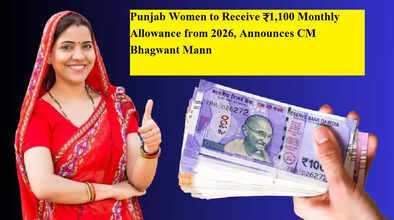Punjab Women to Receive ₹1,100 Monthly Allowance from 2026, Announces CM Bhagwant Mann

Chandigarh, Sep 22, 2025 – The Aam Aadmi Party (AAP) government in Punjab is preparing to fulfill one of its major poll promises by offering a monthly financial support of ₹1,100 to women in the state. Chief Minister Bhagwant Mann confirmed that the scheme will roll out after the state budget for 2026 is approved.
Promise Made During 2022 Elections
During the 2022 Assembly elections, AAP had assured women that, along with free bus travel, they would also receive direct monthly financial assistance. While the free travel scheme was implemented soon after the party came to power, the monetary aid has been pending for more than three years. CM Mann emphasized that women’s economic empowerment remains one of his government’s top priorities, and serious efforts are being made to launch the scheme without further delay.
Opposition Pressure and Public Expectations
Since AAP’s exit from power in Delhi, pressure has mounted on the Punjab government to deliver on its remaining promises. Opposition parties have consistently criticized the state administration for failing to provide the promised cash assistance to women. They argue that while guarantees such as free electricity have already been fulfilled, women have been left waiting for their financial benefit.
According to government estimates, nearly one crore women aged 18 and above in Punjab are eligible to receive this allowance. This makes it one of the largest welfare schemes in the state’s history, with potential to impact households across rural and urban areas.
Scheme Revised to ₹1,100 per Month
Initially, the AAP manifesto proposed a monthly allowance of ₹1,000. However, in May 2024, amid growing criticism over delays, the government revised the amount to ₹1,100 per woman per month. CM Mann said the revision reflects the rising cost of living and the government’s intent to provide more meaningful support.
Neighboring States Already Ahead
Punjab is not the first state to consider such a measure. Neighboring Haryana has already set aside funds for a women’s allowance, while Himachal Pradesh has rolled out a similar financial assistance program. In Delhi, the BJP government also introduced a comparable scheme, adding to the political pressure on Punjab’s leadership.
Debt-Ridden Punjab Faces a Big Test
The biggest hurdle, however, remains Punjab’s fragile financial situation. As per the Comptroller and Auditor General (CAG) report, Punjab’s debt-to-Gross State Domestic Product (GSDP) ratio stands at 40.35%, the highest among Indian states. Mounting borrowings and limited revenue have left little room for new expenditure. Most of the state’s borrowed funds are being utilized for daily operational expenses rather than developmental investments.
This financial strain raises questions about how the government will sustain a scheme of such magnitude, especially when the annual outlay is expected to run into several thousand crores. Economists have pointed out that unless Punjab significantly boosts its revenue, the scheme could add further pressure to its already weak fiscal position.
What Lies Ahead
Despite the financial hurdles, CM Mann reaffirmed his commitment to deliver on the promise. He stated that once the 2026 budget is cleared, women will start receiving the monthly allowance directly in their bank accounts. The government is also working on a transparent mechanism to ensure that the funds reach genuine beneficiaries without leakages.
For now, women in Punjab are waiting with cautious optimism. While the announcement has brought renewed hope, the actual implementation will determine whether AAP can successfully balance its welfare commitments with Punjab’s strained finances.
If rolled out as promised, this scheme could significantly improve the lives of millions of women across the state by providing them with steady financial support, while also setting a new benchmark in welfare politics. However, its success will largely depend on how the state manages its debt and revenue challenges in the coming years.

